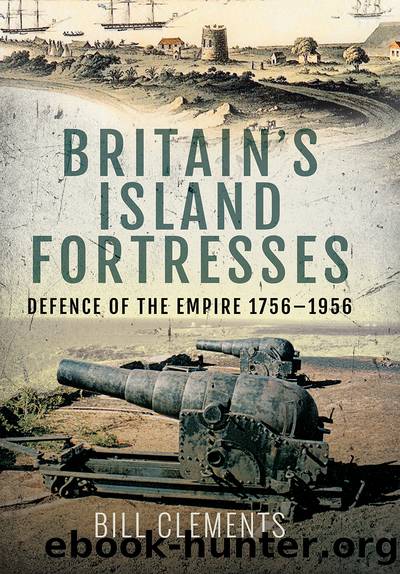Britain's Island Fortresses by Bill Clements

Author:Bill Clements [Clements, Bill]
Language: eng
Format: epub
Published: 2019-09-29T00:00:00+00:00
4 Ã 10-inch 18-ton RML guns
2 Ã 7-inch 7-ton RML guns
2 Ã 64-pdr 64 cwt RML guns
2 Ã 20-pdr RBL guns
Additional heavy guns were recommended to be installed on Elephant Point, with three in shielded emplacements on the Point itself, and two barbette emplacements on the ridge above close to the old Hoodâs Tower. The latter guns would command the waters north-east of the emplacements nearly to Chapel Hill, meeting there at long-range the heavy guns to be mounted on Fort Frederick.
For Colombo the recommendation of the Commission was that 9-inch 12-ton RML guns should replace the lighter 7-inch guns that had been installed as a temporary measure. However, the incoming Inspector General of Fortifications, Major General Sir Andrew Clarke, submitted a reduced scheme for Colombo which substituted four of the new 9.2-inch breech-loading (BL) guns for the 10-inch RMLs recommended by the Commission, and reduced the number of 9-inch RML guns from three to two.16
For Galle, considered to be the most exposed point of Ceylon, it was considered that the fort should be armed with the heaviest guns, so it was proposed that the Star, Eolus, Klippenburg and Triton Bastions should be remodelled to mount 10-inch 18 ton RML guns.17
The following year, 1881, a further commission was established to report on the defences of Ceylon. This recommended a garrison for the island of one infantry battalion, two batteries of artillery and a company of gun lascars, locally recruited personnel, to assist with the manning of the guns. The commission also recommended that Galle should be abandoned as a defended port as it was now used primarily by sailing ships.
As was the case in all colonies there was much debate with the Imperial government on the subject of the cost of maintaining the garrison. The debate was about the total amount to be contributed by the colony to the cost of its defence, and how much was the responsibility of the Imperial government. In 1883 an agreement was reached between the colonial and Imperial governments under which Ceylon was to pay Rs500,000 (£31,250) annually for five years from January 1884, with a review of that figure in 1889. In fact, the total colonial contribution had risen to Rs600,000 by 1888, of which Rs126,700 was for the construction and maintenance of the fortifications. The colonial contribution would continue to rise until in 1894. The total contribution was Rs1,394,500, or £87,156, a tripling in the size of the contribution over a period of only nine years.
A report produced by a Major Barker RE on the defences of Trincomalee recommended the occupation of Great Sober Island in Trincomalee harbour as an alternative to the scheme to construct a battery on Elephant Ridge recommended by the Inspector General of Fortifications. Major Barkerâs telling arguments included the fact that Great Sober Island could not be taken in reverse, was easily accessible from the dockyard and had ample space for barracks and stores out of range of enemy fire. His proposal was that a battery of four 10-inch RML guns should be built on Great Sober Island.
Download
This site does not store any files on its server. We only index and link to content provided by other sites. Please contact the content providers to delete copyright contents if any and email us, we'll remove relevant links or contents immediately.
The Radium Girls by Kate Moore(10924)
The Templars by Dan Jones(4199)
100 Deadly Skills by Clint Emerson(4093)
Rise and Kill First by Ronen Bergman(4026)
The Doomsday Machine by Daniel Ellsberg(3743)
The Rape of Nanking by Iris Chang(3530)
Killing England by Bill O'Reilly(3467)
Hitler in Los Angeles by Steven J. Ross(3450)
Stalin by Stephen Kotkin(3095)
12 Strong by Doug Stanton(3064)
Hitler's Monsters by Eric Kurlander(2741)
Darkest Hour by Anthony McCarten(2655)
Blood and Sand by Alex Von Tunzelmann(2615)
The Art of War Visualized by Jessica Hagy(2424)
Hitler's Flying Saucers: A Guide to German Flying Discs of the Second World War by Stevens Henry(2306)
The Code Book by Simon Singh(2222)
The Second World Wars by Victor Davis Hanson(2140)
Babylon's Ark by Lawrence Anthony(2078)
Tobruk by Peter Fitzsimons(2068)
